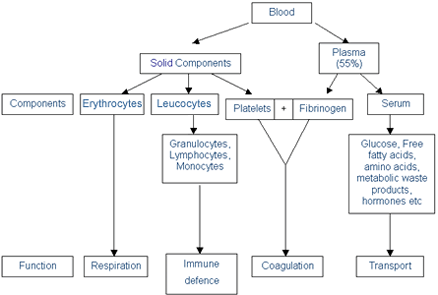Dissolved Components
Blood plasma is a slightly yellowish fluid containing 90% water. Dissolved in it are many proteins (7-8%) such as albumins, which are responsible for maintaining the osmotic pressure in the blood and act as transport proteins for water-insoluble materials and globulins that play a role as antibodies (eg IgG, IgA, IgM) in humoral immunity. The plasma also contains:
- nutrients (proteins, fats, sugars)
- inorganic salts
- metabolic waste products (especially urea)
- enzymes
- hormones
Fibrinogen is a component of plasma essential for blood coagulation. It is a ß2-globulin that is normally present at a concentration of 2-4 g/l.
Cellular Components
Erythrocytes – Blood cells make up about 45% of the blood. Erythrocytes (red blood cells), which contain haemoglobin, are the most numerous at 4-5 million/µl. They take the form of a flat, biconcave disk with a diameter of 7-8 µm (1 µm = 1/1000 mm), are non-nucleated and very flexible (Figure 7).
Composition of the Blood
[swf src=”https://www.cardiachealth.org/wp-content/uploads/2015/12/module1_figure_7.swf” width=500 height=700]Red blood cells contain hemoglobin and are responsible for oxygen and CO2 transport. They are produced in the bone marrow and are broken down in the spleen and liver. They have a lifetime of about 120 days.
Leucocytes
Leucocytes (also known as white blood cells) are present in the blood in much smaller numbers, 4000 – 11000 /µl. Their diameter is more than twice that of the erythrocytes. White blood cells always have a nucleus and exhibit amoeboid movement. They are produced in the bone marrow and mature in the different lymphatic organs (spleen, lymph nodes, tonsils, bone marrow, thymus) into cells with a variety of functions and structural appearance.
Non-specific defense is provided by cells referred to as phagocytes. These cells can recognize, engulf and digest foreign organisms such as fungi, bacteria and viruses. They include:
- granulocytes
- mononuclear phagocytes or monocytes.
Granulocytes (11-14 µm) (also known as polymorphonuclear leucocytes) are the most numerous phagocytic cell type. They circulate in the blood and derive their name from their granular cell inclusion (granulae) easily recognisable under a light microscope. When foreign organisms invade the body, granulocytes leave the blood capillaries, migrate into the affected area and eliminate the invader by phagocytosis.
The mononuclear phagocytes are also involved in the general defence activities. Depending upon their localisation, we distinguish between monocytes (in the blood) and macrophages (in the tissue). Macrophages, as their name suggests, are the largest phagocytic cells with a diameter of 12-20 µm. As well as destroying invading microorganisms they also remove degenerating or ageing endogenous tissue.
A more specific and developed form of the general defence system (specific immunity) is provided by the lymphocytes. These are specific defence cells since they possess on their cell membrane, structures allowing them to recognise specific pathogens (antigens), which they eliminate rapidly, and selectively, after contact.
Stem cells of the lymphocytes, like those of other leucocytes, are produced in the bone marrow. During embryonic development they migrate into the lymphatic organs. Here they mature to produce two different types of lymphocytes:
- T-lymphocytes
- B-lymphocytes
The maturation of the T-lymphocytes depends on the thymus gland (thus the name T-lymphocyte). Here they differentiate further into the following agents of cell-mediated defence:
- killer cells, which release toxins, cytolytic enzymes or complement factors and thereby selectively destroy invading pathogens
- helper cells which, after contact with the antigen, assist the production of antibodies in the B-lymphocytes and activate phagocytic cells by emitting chemotactic agents
- supressor cells that inhibit the activity of other lymphocytes and thereby regulate the immune response.
B-lymphocytes mature in the lymphatic tissue of the intestine and liver. In birds, this function is performed by a rectal gland, the bursa of Fabricius, hence the name B-lymphocyte. B-lymphocytes have specific antigen receptors on their cell surface and in the event of infection can transform into memory cells (large plasma cells) after stimulation by the respective antigen.
These cells constitute the immunological memory since they “memorise” the antigen and, in the event of a repeat infection, immediately trigger the appropriate immune response. Plasma cells produce an antibody which is released into the blood. Here they bind to their target antigen and either render it harmless directly or “mark” it for destruction by the phagocytic cells.
The platelets, (150,000 – 450,000 /µl) are not cells in the true sense. The non-nucleated disk-shaped platelets have a diameter of 2-3.5 µm. They can clump together, ie aggregate, in response to specific stimuli.
Once platelets have aggregated, platelet factors are released and these initiate blood coagulation.

